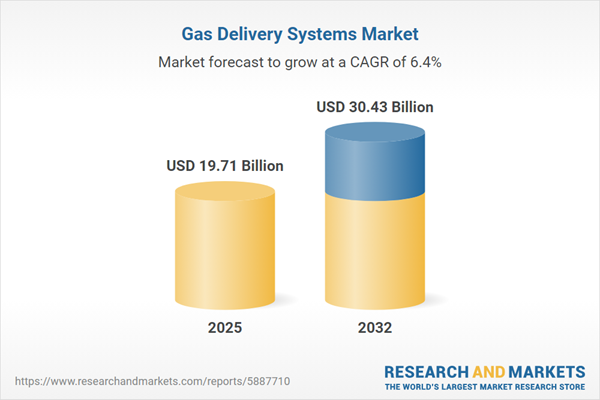Speak directly to the analyst to clarify any post sales queries you may have.
As industries undergo rapid transformation and regulations evolve, organizations need comprehensive intelligence to make confident decisions in the gas delivery systems market. This report provides strategic clarity for senior leaders, highlighting trends, risks, and opportunities crucial for maintaining competitive advantage.
Market Snapshot: Gas Delivery Systems Market Size and Growth
The gas delivery systems market is experiencing robust growth, characterized by a projected compound annual growth rate of 6.39%. Market value reaches USD 18.53 billion in 2024, with forecasts rising to USD 19.71 billion in 2025 and an estimated USD 30.43 billion by 2032. This positive trajectory is underpinned by increasing investments in advanced gas management technologies, tighter compliance demands, and broad-based application across manufacturing, research, healthcare, and energy sectors. Enhanced digitalization drives operational transparency and compliance, supporting organizations operating across multi-site, integrated enterprises.
Scope & Segmentation: Core Components of the Gas Delivery Systems Market
Understanding segmentation empowers decision-makers to identify growth avenues and develop resilient procurement strategies within the sector:
- Delivery Mode: Organizations can select between cylinder tube, on-site generation, and pipeline systems, customizing solutions for both centralized and distributed operations to maximize flexibility.
- Gas Type: Choices span standard and specialty gases, such as argon, nitrogen, oxygen, and carbon dioxide, covering diverse purity and performance requirements, from general manufacturing to high-spec processes.
- End Use: Key industries relying on gas delivery systems include chemical processing, electronics, food and beverage, healthcare, metals, and oil and gas, each governed by distinct compliance and operational priorities.
- Pressure Class: Both high-pressure and low-pressure system designs are available to address safety regulations and efficiency needs in varying facility environments.
- Geographical Coverage: The global market encompasses the Americas, Europe, Middle East, Africa, and Asia-Pacific, reflecting how supply, regulation, and infrastructure standards differ by region.
- Enabling Technologies: Advanced digital control, remote management, and monitoring platforms enable accurate compliance management, predictive servicing, and optimized asset performance, particularly in large, multi-facility portfolios.
- Market Leaders: Leading organizations—such as Linde plc, Air Liquide S.A., Air Products and Chemicals, Inc., Messer Group GmbH, Taiyo Nippon Sanso Corporation, Matheson Tri-Gas, Inc., Parker-Hannifin Corporation, Chart Industries, Inc., Emerson Electric Co., and Iwatani Corporation—advance innovation and address evolving standards through regulatory acumen and technology integration.
Key Takeaways for Decision-Makers
- Digital platforms enhance operational visibility, making it easier for managers to address changing safety and compliance challenges as new rules emerge.
- Broad compliance strategies align internal processes with shifting regional and international regulatory frameworks, reinforcing supply reliability and reducing vulnerability across networks.
- Implementing modular or on-site gas generation solutions helps organizations meet environmental goals and embed sustainability within distributed operations and procurement.
- Using regional procurement structures and pursuing vertical integration can reduce supply chain interruptions, safeguard continuity, and preserve reliability in fluctuating market conditions.
- Efficient market entry into new regions is enabled by agile procurement models and clearly defined regulatory pathways, ensuring scalability and ongoing compliance oversight.
Tariff Impact on Gas Delivery Systems Supply Chains
Forthcoming U.S. import tariffs in 2025 are compelling organizations to reevaluate sourcing and production strategies. This shift increases reliance on domestic and regional systems to ensure dependable supply. Adopting flexible contracting mitigates exposure to external economic variables and helps organizations sustain margins during regulatory shifts.
Methodology & Data Sources
This analysis synthesizes executive perspectives, comprehensive secondary research, and scenario modeling. Triangulated data ensures recommendations are validated and reflect sector realities, supporting reliable risk evaluation and decision-making.
Why This Gas Delivery Systems Market Report Matters
- Equips decision-makers with insights to proactively respond to regulatory developments and leverage innovations in gas delivery system technology.
- Delivers a segmented, global perspective essential for shaping procurement and operational strategies that withstand evolving market forces.
- Provides data-driven analysis that supports organizational resilience and operational improvements throughout the supply chain.
Conclusion
This report offers actionable frameworks for navigating risk, fostering agility, and building sustained strategic advantage as the gas delivery systems sector adapts to new demands and opportunities.
Additional Product Information:
- Purchase of this report includes 1 year online access with quarterly updates.
- This report can be updated on request. Please contact our Customer Experience team using the Ask a Question widget on our website.
Table of Contents
3. Executive Summary
4. Market Overview
7. Cumulative Impact of Artificial Intelligence 2025
Companies Mentioned
The companies profiled in this Gas Delivery Systems market report include:- Linde plc
- Air Liquide S.A.
- Air Products and Chemicals, Inc.
- Messer Group GmbH
- Taiyo Nippon Sanso Corporation
- Matheson Tri-Gas, Inc.
- Parker-Hannifin Corporation
- Chart Industries, Inc.
- Emerson Electric Co.
- Iwatani Corporation
Table Information
| Report Attribute | Details |
|---|---|
| No. of Pages | 181 |
| Published | October 2025 |
| Forecast Period | 2025 - 2032 |
| Estimated Market Value ( USD | $ 19.71 Billion |
| Forecasted Market Value ( USD | $ 30.43 Billion |
| Compound Annual Growth Rate | 6.3% |
| Regions Covered | Global |
| No. of Companies Mentioned | 11 |









